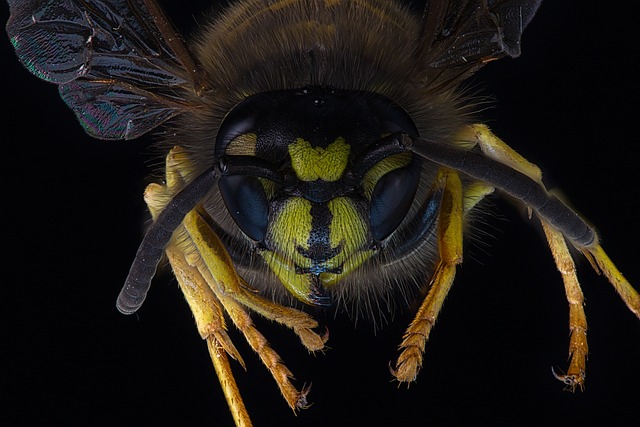Wasp infestations demand swift, expert intervention for effective professional wasp removal. Understanding paper wasps, yellow jackets, and hornets—each with unique behaviors and nesting habits—is crucial for informed infestation management. Professional services offer safety, long-lasting solutions, and prevention, using specialized equipment and techniques to remove nests and wasps. Post-removal, sealing entry points and regular inspections prevent recurrences. By combining these measures, properties can achieve a wasp-free environment.
Wasp infestations can transform your home or business into an uncomfortable, even dangerous zone. Understanding these intricate pests and their behaviors is key to effective control. Professional wasp control services offer a safe, efficient solution for both residential and commercial settings.
This comprehensive guide delves into the world of wasps, exploring various types and their habits. We highlight the advantages of professional removal, detailing the step-by-step process and post-removal precautions, ensuring a wasp-free environment. Discover how expert intervention can restore peace of mind.
Understanding Wasp Infestations: Types and Behaviors
Wasp infestations can be a serious concern for both homes and businesses, requiring prompt and professional intervention for effective professional wasp removal. Understanding these insects is the first step in managing an infestation. Wasps are social insects that live in colonies, typically underground or in voids around structures. They are divided into three main types: paper wasps, yellow jackets, and hornets. Each has distinct behaviors and nesting habits.
Paper wasps, for instance, build nests from paper scraps and construct them above ground, often hanging from branches or under eaves. Yellow jackets, on the other hand, burrow into the ground to create intricate networks of tunnels and chambers for their colonies. Hornets are known for their larger size and more aggressive behavior, often nesting in trees or attics. Recognizing these differences is crucial as it informs the best approach for professional wasp removal and prevents further infestation.
Benefits of Professional Wasp Control Services
Professional wasp control services offer a multitude of benefits for both homes and businesses. Firstly, they ensure safety by removing wasps effectively and efficiently, minimizing the risk of stings or even severe allergic reactions. Expert technicians are trained to handle different wasp species, using tailored methods to protect people and pets while eliminating nests.
Moreover, professional wasp removal provides long-lasting solutions compared to DIY attempts that often only mask the problem temporarily. By addressing the root cause—the nest—professionals prevent reoccurrence for extended periods. This not only saves time and effort but also contributes to maintaining a clean, safe environment, enhancing the overall quality of life for occupants and visitors alike.
The Process of Professional Wasp Removal
Professional wasp removal is a meticulous process that requires skilled technicians and specialized equipment. The first step involves a thorough inspection to identify the wasp nest location, size, and type. Our experts use safe methods to observe the wasps’ behavior, ensuring the safety of both the residents and the environment. Once located, they carefully assess the best approach for removal, whether it’s through a direct extraction or a targeted treatment.
The actual removal process is fast-paced and efficient. Using protective gear, our technicians employ industry-approved chemicals to eliminate the nest and any lingering wasps. Every step is taken to prevent further infestations, sealing entry points and offering recommendations for future protection. After completion, we conduct a final inspection to ensure the area is wasp-free, providing peace of mind for homeowners and business owners alike.
Maintaining Wasp-Free Environments Post-Removal
After a successful professional wasp removal, maintaining a wasp-free environment is crucial for both homes and businesses. The first step is to identify and seal off any entry points that might have been used by wasps to enter the structure. This includes checking for cracks, gaps around windows, doors, or other openings, and ensuring they are properly sealed with appropriate materials. Regular inspections are also essential to prevent future infestations; professionals can provide guidance on what to look for and how often to conduct these checks.
To further deter wasps, it’s recommended to keep the area around the property clean and free of potential food sources. This means promptly cleaning up any fruit that falls from trees, removing standing water, and securing outdoor trash cans with tight-fitting lids. Additionally, planting wasp-repelling herbs like lavender or marigolds near entry points can create a natural barrier without resorting to chemicals. By combining these measures, homeowners and business owners can enjoy a peaceful environment free from wasps and reduce the need for future professional interventions.
When dealing with wasp infestations, especially in residential or commercial settings, professional wasp control services offer a safe and effective solution. By understanding the types of wasps and their behaviors, experts can implement tailored strategies for removal, ensuring these dangerous insects are eliminated promptly. Professional wasp removal not only protects against stings but also maintains a peaceful, wasp-free environment, allowing you to fully enjoy your space. With proper post-removal care, you can prevent future infestations, keeping your home or business safe and comfortable.
